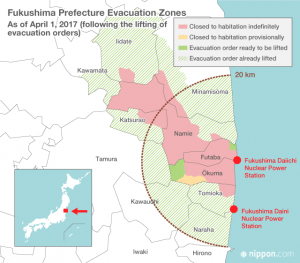The Fukushima Disaster – 6 years on
On the 11th March 2011 ‘The Great East Japan Earthquake’ triggered a powerful tsunami which lead to the deaths of over 15,000 people, the total destruction of 120,000 buildings and catastrophic damage to three nuclear reactors at the Fukushima Daiichi nuclear power plant, causing the second-worst nuclear disaster in history.
The Japanese government were quick to react to the release of radioactive material into the air. A twenty-kilometre exclusion zone around the reactors was quickly established and approximately 154,000 people were evacuated from their homes in the area. Unbelievably, there has to date been no deaths or cases of radiation sickness as a result of radiation exposure at the Fukushima nuclear plant. According to the World Nuclear Association, the level of radioactive material released due to the accident was only 15-18% that which was released at Chernobyl, the world’s worst nuclear disaster.
Shortly after the disaster the Reconstruction Agency was set-up by the Japanese government with a 10-year mandate to rebuild that which was ruined. Part of this mandate was to decontaminate lands, villages and towns so that people can return to their homes and farmland can once again become usable.
Six years on and substantial progress has been made. Earlier this year evacuation orders were lifted in many of the areas around the nuclear power station giving residents the opportunity to return home. Not all however, are expected to do so, some deciding to remain in the areas in which they have created new lives. According to surveys over half of residents said they did not plan to return to their homes when the orders were lifted. In some areas one year on from the lifting of evacuation orders only 20% of residents have returned.
Map showing the extent of the evacuation zones

Future impact of the disaster
The impact of the earthquake is likely to be felt for some decades to come. According to official figures, in total more than 470,000 people were ordered to leave their homes, and as of February 2017 the number of evacuees displaced still stands at 123,000.
Work to ‘make safe’ the Fukushima Nuclear Power Plant is on-going and could take four decades. In February 2017 TEPCO (Tokyo Electric Power Company) reported the maximum estimated radiation level in reactor 2 to be 530 (Sv) per hour. This is substantially higher than the maximum rates of 73 Sv/hour recorded in 2011. To put this in some context, 50% of people receiving a dose of 4 Sv would die. However, this higher level does not mean that overall radiation levels on the site are changing, rather that TEPCO have succeeded in getting closer to the melted fuel.
The disaster has also had a substantial impact on the country’s nuclear energy industry. Most of Japan’s nuclear reactors were unaffected by the earthquake and tsunami, and continued to operate until they reached their next scheduled shut down. However public fears over nuclear energy lead to delays in re-starts leading to the effective shut-down of all of Japan’s 43 operable nuclear reactors. This was estimated to be costing Japan $30 billion each year to pay for imported fossil fuel. Following a review by the Nuclear Regulation Authority the first two nuclear reactors re-started again in 2015, and out of the remaining reactors, 24 are currently in the process of gaining re-start approvals.
The financial bill for the disaster continues to rise. In December of last year, the Japanese government said the estimated costs of decommissioning the Fukushima nuclear power plant and decontaminating the surrounding areas, as well as compensation, storing of radioactive waste, had risen to £150 billion, double the estimate of 2013.
According to the World Bank the Great East Japan Earthquake is likely to be the most expensive natural disaster in world history.


